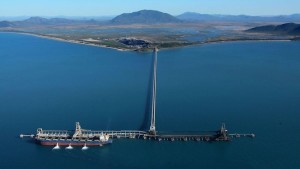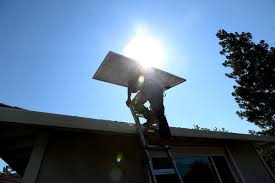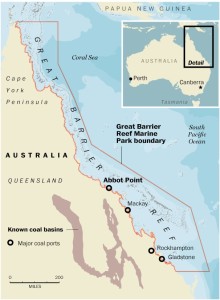More News on Recent Blog Postings: Great Barrier Reef – Solar Systems/Big Utilities

There’s more news on the Great Barrier Reef, more…bad news. I blogged on this natural wonder in OA – Part II. About the coral reefs of this once-spectacular UNESCO World Heritage site being killed by ocean acidification.
Title in the Washington Post the other day was “Great Barrier Reef At Risk?” Writer Karl Gruber says the “dire warning” of the title originates with the Australian government’s plans to start a “massive” expansion of Abbot Point, a deep-water coal port located on the northeast coast. Scientists are reported to claim this project “could be a tipping point” for the treasured marine environment of the Reef.
If interested in facts about the Reef, there are plenty in the article. I vaguely remember reading sometime in the past that the Reef can be, and has been seen from outer space. Another: there are more than 1,500 tropical fish species, and 400 species of coral there. UNESCO calls it “one of the richest and most complex natural ecosystems on the planet.” Again quoting the article: “The amazing [biodiversity] supports tens of thousands of marine and terrestrial species, many of which are of global conservation significance.” Whoa!

28,000 new jobs are predicted in the wake of the expanded port operation, and “many more” ships will come. 28,000 new jobs?! (Must be a typo with one too many 0s.) Problem is current and future shipping enter/exit the port near the reefs. But, the Aussie national government and Queensland municipality lay claim to a protection plan that will cost some $1.5B U.S. A spokesman for the Queensland Resources Council claims that port operations “have successfully coexisted with the World Heritage values of the Great Barrier Reef over several decades.”
What’s the scientific community say? Some disagree with the notion of successful coexistence given a 50% loss of coral over the past 3 decades. Article points to one failed idea already withdrawn by the government, but a couple of other ideas that may be positive for containing the environmental disruption.
Well, if a scuba diver, snorkeler or World Heritage sites tourist, think about packing your bags while there’s still time. If going by ship to Australia, maybe your vessel will make its port-of-call elsewhere along the island’s edge?
Amped-up Solar Panel Sales/Installation
 One of a number of posts about solar panel gain was recent. It was called “Two Basic Camps – Now in Red or Blue.” With references, I shared how solar can be successfully marketed to both liberals (Democrats) and conservatives (Republicans).
One of a number of posts about solar panel gain was recent. It was called “Two Basic Camps – Now in Red or Blue.” With references, I shared how solar can be successfully marketed to both liberals (Democrats) and conservatives (Republicans).
A recent article by Joby Warrick is titled “Industry Tries to Cast Cloud Over Solar Use.” (Good title/good editor.) Well, that’s been going on for awhile. Certain “industry leaders” have decried how solar disadvantages blue collar/working poor communities because middle/upper middle class homeowners can afford to put up solar systems in exchange for very low energy charges in the out years. Meanwhile, the grid owner has a shrinking customer usage base, so has to raise rates, mostly affecting those homeowners who can’t afford a solar, or may be less-than-creditworthy. Well, Duke Energy isn’t one of those certain industry leaders. It’s embraced solar power in a very major way in its grid planning and deployment. And, for another, the Annapolis Housing Authority has been putting solar systems on the roofs of its housing, benefiting tenants with lower energy costs.
 Warrick reports from a presentation prepared for an industry group several years ago: “If demand for residential solar continued [sic] to soar, traditional utilities could soon face serious problems, from ‘declining retail sales’ and ‘loss of customers’ to ‘potential obsolescence’.”
Warrick reports from a presentation prepared for an industry group several years ago: “If demand for residential solar continued [sic] to soar, traditional utilities could soon face serious problems, from ‘declining retail sales’ and ‘loss of customers’ to ‘potential obsolescence’.”
A campaign was mounted by the utility industry’s main trade association calling, in its first phase, for “a push for state laws raising prices for solar customers.” That’s failed “spectacularly” in legislatures around the country. And, here come the “red states” mentioned in the previous post. Conservatives and evangelicals in red states mounted hefty campaigns to defeat the industry trade association’s attempt to raise prices for solar system owners across a number of states.
“In a closely watched case last month [February],” says Warrick, “an Arizona utility voted to impose a monthly surcharge of about $50 for’net metering,’ a common practice that allows solar customers to earn credit for the surplus electricity they provide to the electric grid.”
This is a big article that ought to be read by those of you interested in the industry, or solar providers. (Rick Peters of Solar Energy Services, Millersville, MD, comes to mind as does Kirk Renaud of Common Cents Solar of Chevy Chase.)
An Edison Electric Institute official is quoted in the article, saying: “It’s not about profits; it’s about protecting customers. There are unreasonable cost shifts that do occur [with solar]. There is a grid that everyone relies on, and you have to pay for that grid and pay for that infrastructure.”
Well, my BGE monthly invoice includes a “Distribution Chg” which is second only in size to our wind energy (raw commodity) charge. That distribution charge, of course, is for the grid/other infrastructure. But such may not be the case in other states.
Now, if only someone could refer me to a foundation that makes grants to non-profits for solar projects, then the St. Margaret’s Education Formation facility would be most complete as a sustainable, healthy building project. (LEED Silver would be assured.)
